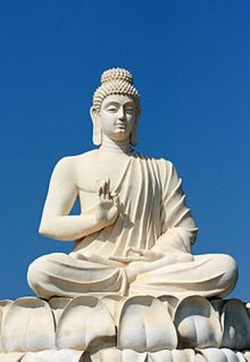Time in Madhyamika Buddhism and Modern Physics
by Victor Mansfield
Published in The Pacific World Journal of the Institute of Buddhist Studies, 1996. Department of Physics and Astronomy Colgate University Hamilton, NY 13346
In any attempt to bridge the domains of experience belonging to the spiritual and the physical sides of our nature, time occupies the key position. Sir Arthur Eddington
In particular, there is a growing interest among the scientific community in Buddhist philosophical thought. I am optimistic that over the next few decades there will be a great change in our worldview both from the material and the spiritual perspectives.
The Fourteenth Dalai Lama
I. Introduction
Perhaps because I began writing this paper a few days after my fifty-fourth birthday, while my human and animal friends are gravely ill all around me, my awareness of time has become so acute. Yet anybody inspired by the doctrine of impermanence realizes that reflection on time is central to both the theory and practice of Buddhism. Since the no-self doctrine denies us any refuge in the notion of an eternal soul, as we commonly understand it, there is nowhere to hide from the truth of impermanence. Here I'll review the principle of emptiness in Prasangika Madhyamika, the Consequence School of Middle Way Buddhism so prominent in Tibetan Buddhism, and discuss how it bears on impermanence. Perhaps in the process we can glimpse how reflection on time is a liberating activity that must express itself in compassion.
In modern physics time also plays a central role, yet subjectively experienced or psychological time is not identical to the physicist's conception of time. Psychologically we are very clear about the radical distinction between the past and the future. We try to learn from the past, but these events are unalterable, while those in the future are unknown and the possibility for influencing them is greater. In contrast, in modern physics microscopic processes are entirely reversible--there is no fundamental distinction between the past and the future. Physical processes can run in what we consider the backwards order and not violate any laws of physics. Yet in the world where we and the Buddha have experience, there are clearly irreversible processes on all sides from the rotting of fruit in my refrigerator to the death of stars in deep space, and of course, to the death of loved ones. In our experience, the temporal notions of past and future are not symmetric like the spatial ideas of left and right. In this sense, time is asymmetric--an arrow of time points from the past into the future. Here I'll nontechnically review how modern physicists have dealt with this dichotomy between the symmetric microscopic level with its reversible time and the asymmetric macroscopic level where we are keenly aware of the difference between past and future and where decay and impermanence surround us.
There is no question of physics proving the great doctrine of Buddhist impermanence nor the worldview implied. Furthermore, since physical theories are a prime example of impermanence, it is a guarantee of obsolescence to bind Buddhism or any philosophic view too tightly to a physical theory. What happens when the theory changes? Do the foundations of our closely linked worldview tremble at each scientific revolution? Nevertheless, science is the reigning worldview in modern culture and so there is a demand to ask how a philosophic or religious view relates to this dominant scientific view. In addition, the Dalai Lama is correct when he says in the opening quotation, "there is a growing interest among the scientific community in Buddhist philosophical thought."
Perhaps a fruitful dialogue can develop between Buddhism and science, one that deepens our appreciation of such ancient truths as impermanence and also fertilizes modern physics, which despite its enormous successes, still suffers from serious conceptual difficulties at its philosophic foundations. Of course, if such a dialogue is to be more than merely drawing pleasant parallels between such diverse subjects as Buddhist emptiness and nonlocality in quantum mechanics,[3] then revision of views must occur in both camps. The dialogue must bear fruit in the normal activities of each discipline. Otherwise, it is difficult to imagine how "there will be a great change in our worldview both from the material and the spiritual perspectives." I hope this paper contributes to the developing dialogue between science and Buddhism and makes some small progress toward a cross-fertilization. In the process we may learn how reflections on time can be, as Sir Eddington says in the opening quotation, a bridge between the spiritual and the physical.
II. Emptiness and Time in Prasangika Madhyamika
To begin my brief sketch of emptiness and time in the Prasangika Madhyamika (abbreviated to Madhyamika in this paper), I'll present two little stories and some comments on them from the Buddhist section of my forthcoming book, Synchronicity, Science, and Soul-Making.[4] Let me begin with a story that relates directly to the objective side of Madhyamika emptiness.
Several years ago I was returning graded term papers (worth about one third of the final course grade) and noticed one student was not receiving a paper. "Jay, I have no paper for you. Did you turn one in?" He said, "Oh yes, I submitted it along with everyone else." I apologized profusely and told him it must be in one of my offices. I would dig it out and grade it for him by the next class. (Then I also held the rotating chairmanship of our department and thus had the chairman's office along with my own in which to spread out and create havoc.)
I searched both offices at school and my office at home and could not find the student's paper anywhere. I could even vaguely recall seeing the paper at some time, but it just would not turn up, no matter how carefully I searched. My guilt started eating at me. Writing a term paper of that size is a very big piece of work, especially for someone as careful as Jay, and I, Mr. Chaos, cannot find his paper. "It must be here somewhere!" I vowed to reform my sloppy practices. Meanwhile, I would use this guilt driven opportunity to clean out all three offices in my desperate attempt to find the student's paper. During my search I would get the clear sensation it was going to turn up in the very next pile. I could almost see the title page now. . . . Nothing, no paper, and no evidence for ever receiving it. "How could I lose that paper?"
Defeated, I returned to the student and confessed I could not find the paper. I asked whether he had another copy or an earlier draft. He said that the one he turned into me was the only copy. I apologized again and offered him an additional two weeks to turn his research notes into another version of the paper. Meanwhile, I would keep an eye out for the paper, despite my having lost hope of finding it.
Early one morning while preparing for class, Jay came into my office. He looked like he had not slept for the last two nights. Before I could even say hello he blurted out, "I lied. I never did turn in a paper. I am sorry." I'll skip the long conversation we had and what came of it. That is not the point.
The point is that in my frantic and fruitless search for the term paper I was sure it was around somewhere, and that I would warmly embrace it with a mix of relief and satisfaction when it appeared. My vague image of the paper would be clarified and objectified. When found, the term paper would sit there and accuse me of my stupidity. In fact, my expectations instantly dissolved from the negative realization that the paper never existed and so could never be found. I had expectations and fantasies, but nothing to support them.
My belief in the false existence of that term paper is precisely analogous to the false belief in what the Madhyamika calls inherent or independent existence--the denial of which is their doctrine of emptiness. The major translators and commentators, such as Hopkins[5] and Thurman[6] and Tibetan scholar-monks such as Tenzin Gyatso, the fourteenth Dalai Lama,[7] or Geshe Kelsang Gyatso[8] who teach extensively in the West, use a variety of words to describe what is denied in the emptiness doctrine or the "negatee" as they call it. They use inherent existence (svabhavasiddhi) interchangeably with such terms as independent existence, intrinsic existence, substantial existence, intrinsic essence, or intrinsic self-nature to mean our most innate, unreflective, and pragmatic belief about the way subjective and objective phenomena exist.
We may divide this innate and unreflective belief in inherent existence into two pieces: First, that phenomena exist independent of mind or knowing, that "underneath" or "behind" the psychological associations, names, and linguistic conventions we apply to objects like bell or tree or term paper that something objective and substantial exists fully and independently from its own side. Such objects seem to provide the objective basis for our shared world. Second, these objects are also believed to be self-contained and independent of each other. Each object being fundamentally nonrelational, it exists on its own right without essential dependence upon other objects or phenomena. In other words, the essential nature of these objects is their nonrelational unity and completeness in themselves.
Our false belief in inherent or independent existence is the basis upon which we generate our desires and aversions. As we are taught in the second of the Four Noble Truths, these cravings and aversions, these desires, are what generate the suffering permeating all experience--the first Noble Truth. Madhyamika claims that only when we root out this false belief in inherent existence can we realize our potentiality for Buddhahood, for becoming beacons of wisdom and compassion.
The trouble with the false belief in inherent existence is that it includes a conviction that a diligent search will reveal it clearly before us where we can embrace it. The object's essence, its self-standing nature, will transparently shine forth. But in truth this self-standing nature is no more existent than that term paper. While something inherently existent has never been found in the past and will never be found in the future, the paper eventually did exist--although not the one I was initially seeking, but rather its replacement. (Can we truly replace something that never existed?)
The arguments denying inherent existence are extensive and occupy much of the Madhyamika Buddhist literature on emptiness. Rather than review these arguments in detail, I'll boil these brain-splitters down to their essence. They all amount to showing that inherent existence is "unfindable upon analysis." This means that when you search deeply for the object or subject believed to exist inherently, you come up with no more than I did when searching for the student's paper. Rather than find an independently existent phenomenon, these searches reveal an object or subject deeply and inextricably involved with its surroundings and the searcher, the person doing the analysis. (Any general object or subject can be considered a phenomenon, something we can know.)
The searches never yield independently existent objects, but rather those that are deeply dependent in three related ways. First, all phenomena are dependent upon "causes and conditions" or upon the vast network of causal factors and conditions that make a thing possible. The apple tree outside my window depends deeply upon favorable soil, light, water, disease control. For these reasons it lacks independent existence.
Second, all phenomena are dependent upon the whole and its parts and their relationships. For example, my apple tree depends upon having branches, trunk, leaves, all arranged in some well-defined way that we recognize as a tree. Consider the definition of an intrinsically existent object. Because an independent essence or self-nature must be self-contained and isolatable, by its very definition, an inherently existent phenomenon must be a partless essence. It cannot therefore be distributed over parts or shared between the whole and the parts. Yet, since we can always analyze phenomena into whole and parts, independent existence cannot inhere in them. Although we unreflectively consider inherent existence to be the touchstone of reality, its deep logical inconsistencies condemn it to nonexistence.
Third, and most profoundly, all phenomena are dependent upon imputation or mental designation. We continuously receive an immense avalanche of information that we organize, distill, and coordinate with other experiences. We cut up the seamless rush of experience into units of intelligibility (color, texture, memories, associations). Then we collect these items together and designate or name it a tree. Mind is constructive of its world, the only world we can know. We mentally designate, impute, or name that complex of sensations, memories, and expectations to be a tree. This is part of the mind's normal job. The problem comes when the mind erroneously invests the designated object with the nonexistent property of inherent existence. In other words, we illegitimately project the false notion of inherent existence into phenomena and then suffer the consequences of this projection.
It's quite an extraordinary idea that inherent existence, what we erroneously consider the core reality of an object, is simply nonexistent and furthermore that we falsely invest objects with this nonexistent. Upon that false projection we build our cravings and aversions and keep spinning the wheel of samsara. We must awaken from this ignorance if we are permanently to break out of the realm of suffering.
In truth, all objects exist only as sets of relationships or dependencies--between various objects and between the object and the knower who mentally designates them. No core of self-nature or intrinsic essence supports our names, linguistic conventions, and projections. Nothing exists "underneath" our imputations or mental designations. Objects are none other than dependency relationships and names. In other words, all phenomena exist as a species of dependent arising--dependent upon causes and conditions, whole and part, and mental designation. This view thoroughly denies the mind-matter split of Cartesian dualism, the core of many of our Western prejudices that impede both our philosophic and scientific understanding.
It is natural to ask that if things lack inherent existence, if they are empty, then how can they function? How can an ultimately empty tree bear fruit that we eat? According to the Madhyamika, the very emptiness of independent existence of all phenomena is what allows them to function through their relationships and be sources of help and harm. In contrast, if objects inherently existed then they would of necessity be immutable and impotent, unable to act on us or we on them. Within this ultimately empty but conventionally existent world we must win our Buddhahood and thus they call our world the "womb of the Buddhas." Philosophically we must be able to move back and forth between the ultimate and conventional truth of phenomena.
Next let me turn to the subjective side of emptiness, again via a little story from my book. A few years ago I got the strong urge to go canoeing on a nearby lake. I've always enjoyed canoeing since my childhood and the beautiful late spring day seemed to cry out for it. A friend lent me his canoe and my wife and I were soon paddling along the shoreline enjoying the beauty and peace of nature. We were both extolling the beauties of Seneca Lake and saying how conducive canoeing was to a relaxing and aesthetic appreciation of nature. Suddenly a water skier was heading straight for us at top speed. He veered to the side at the last possible moment thereby completely drenching me and my wife with cold water. Sputtering disbelief, shock, indignation, then rage--all exploded inside me. "That damn kid! If he tries it again, I'll stand up in the canoe and whack him with the paddle! How could he do that to me. . . . to me?!" After a few moments of intense indignation I began to laugh heartily, marveling at how quickly my feelings changed from nature mystic to Attila the Hun, from the aspiring Bodhisattva to bloodthirsty monster. I also guiltily recalled how often Buddhism emphasize the control of anger. For example they say, "How are we harmed by our anger or hatred? Buddha has said that hatred decreases or destroys all our collections of virtue and can lead us into the lowest of the hell realms."[9]
However, the main point here is a philosophic one, rather than a moral one--although in Buddhism they always closely connect. From the philosophic perspective, the Madhyamika notes that right at the height of my indignation there was a clear experience of the I--the one we all firmly believe inherently or independently exists. Certainly I had no concern for "turning the other cheek" or for the doctrine of Universal Compassion or any such pious principles. But the critical thing is the I, the "me" believed to exist independently, standing in bold relief in the light of my indignation.
It is easy to be led astray by the anger in my story, but that is not the point. The important thing is that at these times we can most easily see the powerful sense of I or me. Perhaps another simple example will make this clear. Imagine an academic who is wrongly accused of some gross form of plagiarism. His shock and disbelief will quickly turn to indignation. "I would never do such a thing! I am scrupulously honest about that sort of thing," he might exclaim. Right at the height of his indignation there is a very strong sense of an I, one unjustly accused, honest, and thinking frantically how he can clear his good name.
This I or me that we instinctively believe inherently or independently exists is thoroughly denied in the doctrine of emptiness. The Madhyamika also goes well beyond denying this coarse or low level of the ego. That is just the beginning of their no-self doctrine. They claim that any identifiable level of subjectivity is empty of independent existence. Tenaciously clinging to the false belief in an independently existent subject or a self is the primary cause of our suffering, of our bondage to samsara.
For the Madhyamika, belief in inherently existent objects and subjects is the taproot of the pervasive suffering mentioned in the Four Noble Truths. Falsely believing that objects or subjects inherently exist, we ascribe more attractiveness or unattractiveness, generate more craving or aversion, to them then they actually deserve. Upon this foundation of the false belief in inherent existence we build all our emotional attachments, our chains to samsara. These attachments drive us endlessly toward or away from objects and people. We compulsively quest after or flee from objects we falsely believe inherently exist.
We may think inherent existence provides us with our most fundamental reality, but this belief in an inherently existent subject or I, this "self-grasping," is the millstone dragging us to the bottom of the ocean of samsara. This self-grasping leads directly to pervasive egotism, self-love, or "self-cherishing," that is putting our own concerns and desires before all else. Philosophic views, whether conscious or not, always have powerful consequences: wrong ones lead to suffering, correct ones to liberation or enlightenment. Because this false conception of inherent existence is the root of suffering, it must be pulled out, painfully extracted.
Of course, it is no easy matter to deny inherent existence in all objects and at every level of subjectivity. We have the great danger of a largely imaginary view of our attainment and only fattening our ego rather than realizing it as empty. Therefore, a competent guru or spiritual guide is usually a necessity when attempting to realize emptiness.
The denial of inherent existence does not mean that objects do not exist (the extreme of nihilism). They surely have a conventional or nominal existence and they function to provide help and harm, but they totally lack independent or inherent existence. They formalize this idea in the doctrine of the two truths. From the ultimate point of view, all subjective and objective phenomena are totally lacking in independent existence or in their own self-nature. This is the Ultimate Truth--that emptiness or selflessness of phenomena is their highest quality, their most profound nature. However, from the everyday realm of action, commerce, and spiritual practice, objects have a conventional nature. They function; they are efficacious and must be dealt with on this level. For example, ultimately, Tibet is totally without inherent existence; nevertheless, when discussing its political future and that its citizens have suffered mightily, then we are to treat it as people conventionally treat things in the world. Ultimately all phenomena are empty of inherent existence, yet in practical or conventional living we must treat them with the respect conventionally granted such objects. However, always keeping their emptiness in mind, we do not become slaves to our attachments--whether to a country or a person or our own life.
With this sketch of emptiness, let me briefly comment on impermanence. As I mentioned above, if things inherently existed then they would of necessity be immutable and impotent, unable to act on us or we on them. But the ultimate truth of objects is their emptiness, their lack of inherent existence. Objects exist conventionally and are effective in the world of action because of their relationships and interdependence with other objects and the knower. That the apple exists in dependence upon its whole and parts, causes and conditions, and on our mental designation or naming is what makes it an edible fruit, what allows us to experience it and be nourished by it. More important for impermanence, these very defining relations and co-dependencies and their continuously shifting connections with each other guarantee that all objects and subjects are impermanent, ceaselessly evolving, maturing, decaying, and transforming. In short, emptiness and impermanence are two sides of the coin of existence and therefore transformation and change are built into the core of all entities, both subjective and objective.
III. Asymmetric Time in Modern Physics
1. Symmetric time at the microscopic level
Imagine a pool table with a video camera mounted on the ceiling above the table and pointing down. Now make a video of a ball bouncing off a cushion at any angle. Then run the video backwards and notice that if we are not told the conventional order of events we would have no way to distinguish the usual order of events from the reversed order. This follows because no laws of mechanics are violated in this reversed collision of the ball with a cushion. Here is an example of a time symmetric process--a process that looks the same or obeys the same physical laws whenever the time order of events is reversed.
Let's make a video of the more complicated example of starting the pool game by shooting the cueball at the initial triangular array of balls. In this more complicated set of interactions the balls collide off each other and the cushions and some go into the pockets. Now if we ran this video backwards, it would be easy to tell it is being run backwards because we know quite well what a cueball does when it strikes the rack of balls. Nevertheless, all these complicated motions are still time-symmetric. If by some elaborate contrivance we launched each ball with its reversed velocity just after the break, then the balls would execute a complicated series of collisions, form into a perfect triangle, and eject the cueball back toward its starting point. Now if this contrived video were run backwards then a viewer would see it as just the normal break that begins a pool game--nothing special--even though it is actually a time reversal of the normal break. Such are the consequences of time-symmetric or time reversible laws seen throughout all physics at the microscopic level.[10]
However, if someone cracked an egg on the pool table, then a reversed video in which the spread out egg pulls together and fits itself back into the shell would be easy to spot as a fake. Nobody could reverse such a video and confuse the viewer about the correct time sequence. To understand this obviously asymmetric process, one with a clear "arrow" pointing from the past to the future, one built upon time-symmetric underlying laws, we must study more complicated systems than a few colliding balls. We need to understand a little modern statistical physics.
2. Understanding Time Asymmetry in Statistical Physics
The modern discussion of how we could understand the obvious asymmetry of time when the underlying laws are symmetric began with Ludwig Boltzman in the late nineteenth century. He was deriving the laws of thermodynamics, the laws governing the steam engine and the energy conversions at the heart of the Industrial Revolution, from the statistical properties of gases governed by Newton's Laws of mechanics--from statistical mechanics. Boltzman and others developed a precise notion of entropy as a measure of disorder. The greater the disorder in a system, the greater the entropy. Thermodynamics has the famous Second Law, which states that all systems isolated from their environments have a constant or increasing entropy. (The meaning of "isolated" will become clear below.) An important consequence of this Second Law is that any energy generation process must create some entropy. It cannot be 100% efficient. What is more, entropy increase always corresponded with the usual direction of time, the asymmetric distinction between the past and the future. Thus, if we can understand what entropy is and why it always increases with time, then we can understand how time-asymmetric process arise from the underlying symmetric laws.
Consider a box with simple gas atoms confined to one half as shown in Figure 1. Assume this box is fully isolated from its environment; that there are no energy exchanges, interferences, or interactions with the environment. (Of course, postulating such an isolated and self-standing existence to this box would make any Madhyamika Buddhist extremely uncomfortable, because they claim such an object could never exist without relationships.) The total energy of the box is constant, since the collisions between the walls and the particles and among the particles conserves energy. (Even if they did not conserve energy, since the box is fully isolated it cannot exchange energy with its environment, so the total energy of the box must remain fixed in any case.)
In preparation for the simple and elegant ideas that began with Boltzman let me briefly discuss the seating of patrons in a movie theater. Imagine a theater in which an aisle divides the seats such that half are on the left and half are on the right. Consider the case when the patrons occupy only half the seats--those just on the left. Even with all the patrons sitting just on the left, there are many different ways of seating individuals. Let's call each distinct way of distributing individuals in seats a microstate. To be general we'll not be constrained to seating people next to their friends. Even in a small theater many microstates are possible that satisfy the constraint of only filling just the seats on the left. For example, just interchanging the seating of any two patrons gives another distinct microstate. However, if we allowed the same number of people to sit anywhere in the theater there would be a much larger number of available microstates, since there are many more possible ways of getting the patrons seated when the entire theater is used. In my idealized example, each acceptable microstate is equally likely. My ideal patrons are neither concerned with whom they sit nor where they sit in the theater. They randomly distribute themselves in the seats and thereby make each acceptable microstate equally likely of realization. Given the equal probability of any microstate and the overwhelmingly greater number of microstates available when we permit seating on both sides, it is exceedingly unlikely that all the patrons would be found sitting on just one side. With these ideas we are now ready to understand some statistical physics of the gas in the box we were just considering.
We can enumerate the total possible number of ways, or microstates, for which individual particles could distribute themselves in half the box and keep the energy fixed. For any significant amount of gas this will be an enormous number of microstates. For example, for just two grams of hydrogen gas there are 6.02217x1023 hydrogen molecules (H2), so there are an immense number of ways to arrange the gas in half the box with the required energy. The greater the number of acceptable microstates the greater the entropy, since the less we can specify about the state (which microstate it is in), the greater the disorder, the greater the entropy. Just as in the movie theater, we know that each acceptable microstate is equally likely of realization, of being the microstate that actually obtains at a given time. Now remove the partition between the halves of the box. Since there are many more microstates compatible with being in both halves of the box and each microstate is equally likely, then it is vastly more probable that the gas will be evenly distributed throughout the box as in Figure 2. (This is completely analogous to my idealized movie patrons.)
In summary, the overwhelmingly greater number of microstates for the gas occupying both halves of the box instead of only half and the equal likelihood of each microstate guarantees the overwhelming improbability of ever seeing a gas spontaneously arrange itself in just half the box. Since the states with the gas evenly distributed throughout both halves is more disordered (we can specify less about the gas location) entropy increases. This direction of entropy increase after removing the partition corresponds to our usual sense of the arrow of time. That is, in isolated systems entropy increases with what we consider advancing time.
For many years I followed the text book of choice for a junior-senior level course in statistical physics and thermodynamics and presented, with appropriate mathematical detail, the above argument to my students for why entropy should increase and why time has the observed past-future asymmetry. Unfortunately, I recently found that the argument is wrong! The basic problem is how from the dynamics of many particles undergoing time-symmetric motion do you actually get time-asymmetric motion? Let's return to the theater to illustrate the point.
Imagine another movie theater, samsara cinema. Here start with all the patrons sitting on the left and allow them to follow their whims for moving around. Perhaps the guy next to me is spilling his buttery popcorn all over me or the kids behind me are squirming around too much. I move to avoid them. Likewise for everybody else. However, in samsara cinema, although everybody can choose new seats and move to them, they never sit down. As soon as they move to another seat they find it not to their liking and move to a new one without sitting--samsara is a restless condition. There is thus constant motion from one seat to another. Then a full characterization of a microstate after the start of moving around gives each person both a location and a velocity.
Consider the initial microstate, S0, with everybody on the left (the low entropy one). After an arbitrary time a state S1 is generated with people spread throughout the theater (a higher entropy state). For each S1 there is another microstate, which is equally likely, call it, S1*, with everybody in the same location, but with their velocities reversed (all velocities vectors, V, changed to -V). Assuming reversible interactions for movie patrons (a patently false assumption), these velocity reversed microstates will, in whatever time it took to generate them from S0, result in the original condition with everybody on the left. Each velocity reversed patron simply retraces their steps and gets back to their original position. This must follow if we assume that all patrons move and interact only with time-symmetric dynamics. If we translate this argument to Boltzman's gas we see that after a very short time (the particles move and interact quickly) there is a significant probability of the particles being in just half the box as in Figure 1. So the original argument for entropy increase and time-asymmetric processes collapses in a heap.
Physicists have good reasons for being deeply committed to the Second Law of thermodynamics and controversy surrounds the details of the proper argument for entropy increases. However, in the last four decades the main issues have become clear.[11] We now understand that the whole notion of a system permanently and completely isolated from its environment is the root of the problem. (Are the Madhyamika grinning?) We now realize that we must account for how the box got into the low entropy state of all particles in just one half. This did not result from just waiting a long time for random motions to throw the gas all to one side, but from some lab technician evacuating one half and placing gas in the other. This preparing the box in a low entropy state must generate more entropy elsewhere in the universe. For example, the technician consumed calories from rice and tofu and radiated energy from herself and her equipment that eventually went into deep space. In other words, the box had its entropy put into a low condition by processes outside itself, but at the expense of a much greater entropy increase elsewhere in the universe.
As we have long known, the energy emitted into space from her activities can only radiate into outer space because the universe is expanding. If the universe were not expanding then any line of sight when extended far enough would land on a star surface. Then the effective temperature of deep space would be that of the surface of stars. Then space would typically have a temperature comparable to the surface of our sun (5800 °K) rather than the 3 °K it actually has. Since entropy can only increase when energy moves from high to low temperature regions, the simple process of radiating our body's energy into space would be blocked in a static universe. Thus the technician could not locally reduce the entropy in the box by generating more entropy elsewhere in the universe--unless her body temperature were higher than the average temperature of the surface of stars!
All systems organizing themselves or decreasing their entropy, whether it is the growing of a soy bean or the crystallization of a snowflake, are decreasing entropy in one location that must be made up by a greater entropy generation in another. Not only is the energy from the technician's food and her equipment eventually traced back to our sun, but the sun's low entropy is critical. Energy generation processes, whether the digestion of our food or the workings of a nuclear power plant, are totally dependent upon our solar system being in a low entropy condition. What causes the sun and other stars to be in a low entropy condition? This occurs because the expansion of the universe was faster than the nuclear generation rates in the first three minutes of the big bang. This means that in the first three minutes of the big bang, when nearly all the helium (about 25% of the total mass in the universe) was formed, the universe expanded so quickly that after three minutes it was too cool for nuclear reactions to occur. If the expansion and cooling were much slower then all the matter in the universe would form into a very stable isotope of iron, an inert and high entropy condition. Then the stars would not shine, there would be no great entropy gradients in the universe, no time asymmetry, and, of course, no life as we know it.
Local time-asymmetry, such as the decay of any biological system, including our own bodies, must be accounted for by connecting it to the expansion of the universe. This extraordinary result has many technical twists and turns, but the central idea is clear: increasing entropy and time-asymmetry owe their existence to the largest and earliest processes in the universe and its continued expansion. This is a long way from the notion of an isolated and noninteracting system, so abhorrent to a Madhyamika. In this way, when you pour milk into your coffee and the mixture comes to the same temperature and a higher entropy than when the fluids were separated, you are profiting from the universe's expanding and cooling before iron-56 could form. Similarly, you can trace the decay of your tooth, and the resulting entropy increase, to the earliest and largest processes in the entire universe. (You thought it was all about flossing!)
IV. Summary and Conclusions
While I was completing the section above on Madhyamika emptiness-impermanence, Leo, the best dog I ever had, died. Of course, it is a small loss compared to losing a loved one. Nevertheless, here in the womb of the Buddhas this sorrowful loss drives home again the asymmetry of time, the reality of impermanence. There will be no more long walks in the woods with Leo, no more enthusiastic greetings after a long day at work, no more solace from an affectionate friend. The future holds out the possibility of another dog, but Leo is irreversibly gone. I outlined something of the Madhyamika idea of emptiness-impermanence, which shows how the emptiness of all phenomena, their lack of independent existence, implies that they must exist though continually changing relationships, co-interdependence with their surroundings and the knower. My playful wrestling on the floor with Leo and my sons, Leo's stealing our socks, the wild chases though the house to retrieve them that Leo so loved, defined us all, made us who we are. Ultimately Leo is only a complex set of relationships, of actions and reactions, of history, psychological projections on those beautiful sad eyes, or reactions of disgust at the body parts of wild animals dragged into the yard. Although I know (intellectually) that the lack of independent existence in all things, emptiness, implies impermanence, I inveterately impute inherent existence on Leo and build my attachments and aversions on that false imputation, that false projection. Not only does this false attribution of independent existence chain us to the wheel of samsara, but it also is the basis of our self-cherishing, our egotism, and our inability to act compassionately.
I also sketched above how, according to modern physics, the very connection that each object has with the earliest events in the universe and its present largest scale expansion guarantees the Second Law of thermodynamics, the inevitability of increased entropy, disorder, decay, and time-asymmetry from underlying time-symmetric laws. From the Madhyamika point of view, this extraordinary result beautifully illustrates how emptiness, the deep dependency and interrelatedness with the universe, brings about impermanence. In retrospect we can see that assuming systems, such as the box of gas, have an isolated existence, free from interactions with its environment, led us astray and prevented us from understanding how time-asymmetric processes could ever result from underlying time-symmetric laws. Perhaps if Madhyamika emptiness inspired the physicists working in statistical mechanics, they would never have made this assumption and the progress of statistical physics would have been more rapid.
We always pursue science within a matrix of philosophic and cultural beliefs--not all of which are helpful for its progress. I believe there are other areas in physics, especially the conceptual foundations of quantum mechanics, where inspiration by Buddhist philosophic principles might also be fruitful for the development of physics. On the other hand, reflecting on some fundamental topics from modern physics can enliven and deepen our understanding of Buddhist principles. Certainly more effective examples from modern physics can illustrate Buddhist principles than such quaint notions as "sweaters made of turtle hair."
Yet, however beautiful the parallels and fruitful the synergy between pivotal Buddhist doctrine and modern physics, we clearly cannot fall into the trap of binding them too tightly. Physical ideas and theories are evanescent and so we should not link any philosophic view too tightly to them, otherwise the next scientific revolution will make all our efforts obsolete. On the other hand, I applaud the Dalai Lama when he says that if scientific analysis convincingly refutes a core Buddhist position then Buddhism must give up the view. For example,
Buddhists believe in rebirth. But suppose that through various investigative means, science one day comes to the definite conclusion that there is no rebirth. If this is definitively proven, then we must accept it and we will accept it. This is the general Buddhist idea.[12]
Such a nondogmatic attitude that is open to revising even the most sacred beliefs of Buddhism is obviously appealing to modern Westerners.
Perhaps even more important than a potential synergy between Buddhism and physics is the possibility that through reflecting deeply upon the great truths of emptiness-impermanence, we will increase our compassion. In this day of rampant nationalism, fundamentalism, and zeal for tax cuts rather than securing a quality life for all, we could use more compassion. If, as physics claims, our distinction between past and future, the increase of entropy all around us, is dependent upon the first three minutes of the universe and its continuing expansion, how much more are we deeply related to all inhabitants on "spaceship earth?" If my interrelatedness to persons in the ghetto or a refugee camp is as profound as the doctrine of emptiness maintains, then suffering in one part of the great body of humanity affects us all. As the Dalai Lama puts it:
Each of us has responsibility for all humankind. It is time for us to think of other people as true brothers and sisters and to be concerned with their welfare, with lessening their suffering. Even if you cannot sacrifice your own benefit entirely, you should not forget the concerns of others. We should think more about the future and benefit of all humanity.
Also, if you try to subdue your selfish motives--anger, and so forth--and develop more kindness and compassion for others, ultimately you yourself will benefit more than you would otherwise. So sometimes I say that the wise selfish person should practice this way. Foolish selfish people are always thinking of themselves, and the result is negative. Wise selfish people think of others, help others as much as they can, and the result is that they too receive benefit.
This is my simple religion. There is no need for temples; no need for complicated philosophy. Our own brain, our own heart is our temple; the philosophy is kindness.[13]
Acknowledgments
I offer my thanks to Professor Shimon Malin of the Physics Department of Colgate University for useful comments upon an earlier version of this paper. I thank my spouse, Elaine, for many stimulating ideas, for reading and commenting on this paper, and for teaching me the power and beauty of love. I express my deep gratitude to His Holiness, the Dalai Lama, for inspiring my study of Buddhism, encouraging me to consider the relationship between science and Buddhism, and for being an extraordinary exemplar of wisdom and compassion. I offer my deepest gratitude to the late Anthony Damiani, founder of Wisdom's Goldenrod, who taught us veneration for many great philosophic-religious traditions without restricting us to any one. His zeal for truth combined with compassion inspired us to work toward a personal realization of the great truths of these traditions.
References
Eddington, Arthur The Nature of the Physical World (Univ. of Michigan Press, Ann Arbor, 1968) p. 91.
Gyatso, Tenzin, A Policy of Kindness (Snow Lion Publications, Ithaca, NY, 1990) pp. 71-72.
For some examples see, Mansfield, Victor "Madhyamika Buddhism and Quantum Mechanics: Beginning a Dialogue," International Philosophical Quarterly, Vol. XXIV, 4, 116, (1989) pp. 371-391; "Relativity in Madhyamika Buddhism and Modern Physics," Philosophy East and West, Vol. XI, 1, (1990) pp. 59-72; or "Possible Worlds, Quantum Mechanics, and Middle Way Buddhism," Symposium on the Foundations of Modern Physics 1990 (World Scientific Publishing Co. Pte. Ltd., Singapore, 1991) pp. 242-260.
Mansfield, Victor Syncrhonicity, Science, and Soul-Making (Open Court Publishing, Chicago, IL, 1995). To be published in the fall of 1995.
Hopkins, Jeffrey, Meditation on Emptiness (Wisdom Publications, London, 1983) and Thurman, Robert, Tsong Khapa's Speech of Gold in the Essence of True Eloquence (Princeton University Press, Princeton, NJ, 1984).
Thurman, Robert, Tsong Khapa's Speech of Gold in the Essence of True Eloquence (Princeton University Press, Princeton, 1984).
Gyatso, Tenzin, The Buddhism of Tibet, Translated by J. Hopkins and L. Rimpoche (George Allen and Unwin, London, 1975); T. Gyatso, Transcendent Wisdom, Translated by B. A. Wallace (Snow Lion Publications, Ithaca, NY 1988).
Gyatso, Kelsang, Heart of Wisdom (Tharpa Publications, London, 1986).
Gyatso, Kelsang Meaningful to Behold (Tharpa Publications, London, 1986) p. 122.
Like others who write on the physics of time-asymmetry, I am neglecting the discovery in 1968 of the truly time-asymmetric decay of neutral K-mesons, since this interaction cannot account for macroscopic time-asymmetry.
For the philosophic reader I recommend Horwich, Paul, Asymmetries in Time (Massachusetts Institute of Technology Press, 1987), especially chapter 3; or for a more technical treatment. Halliwell, J, P?rez-Mercader, J, and Zurek, W. (edts.), The Physical Origins of Time Asymmetry (Cambridge University Press, Cambridge, England, 1994).
Gyatso, Tenzin, A Policy of Kindness, p. 68.
Piburn, Sidney, edt., The Dalai Lama: A Policy of Kindness (Snow Lion Publications, Ithaca, NY 1990) p. 58.
Victor Mansfield, Professor of Physics and Astronomy at Colgate University, teaches physics and astronomy along with Jungian Psychology and Tibetan Buddhism. He has published widely in astrophysics, physics, philosophy, and psychology, including his recent book, Synchronicity, Science, and Soul-Making (Chicago: Open Court Publishing, 1995).














